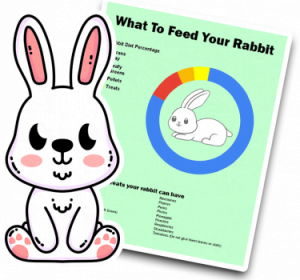
Rabbits are mammals known for their ability to reproduce rapidly. Their reproductive system and cycle differ from that of humans and other animals. While we have a male rabbit, getting to know the female rabbit’s reproductive cycle is a big part of owning an indoor domestic rabbit.
Female Rabbits (Also known as Doe) do not menstruate due to being induced ovulators which means they do not ovulate on a 28-day cycle. However, they will ovulate when they find a suitable male rabbit to mate with. This ovulation process starts during or before the mating process.
Due to this, a Doe will be able to conceive as soon as she has given birth. However, this does not necessarily mean a female rabbit will immediately get pregnant.
A common misconception about rabbits is that they produce menstrual blood due to blood in their urine or red coloring. If your rabbit has blood in their urine, seeking a veterinarian to assist you further is urgent. If your rabbit’s urine looks red but not like blood, this usually indicates a change in their diet or medication and shouldn’t be cause for concern. However, if you are concerned, you should take a photo of the urine and take it to a vet.
To understand why rabbits don’t have periods, we must first explore the unique characteristics of their reproductive process, which we will cover in this blog post.

Female rabbits, known as does, have a complex reproductive system. Their ovaries produce eggs, which are released during ovulation. However, unlike humans, rabbits do not have a monthly menstrual cycle. Instead, they experience what is called an estrous cycle.
Due to having an estrous cycle, rabbits aren’t fertile all year round. This means they will only ever be fertile when necessary.
We recommend spaying your female rabbits to help prevent uterine, ovarian, and mammary gland cancers.
Necropsy cases had a tumor prevalence of 14.4% in both sexes or 19.8% in female intact rabbits of all age groups, and up to 47.2% or 66.7%, respectively, in rabbits older than 6 years. Overall, the most common tumor types were uterine adenocarcinoma (prevalence in female intact animals: 13.1%), lymphoma (prevalence: 2.8%), and thymoma (prevalence: 2.1%).
Neoplasia and Tumor-Like Lesions in Pet Rabbits (Oryctolagus cuniculus): A Retrospective Analysis of Cases Between 1995 and 2019
The estrous cycle is a vital aspect of rabbit reproduction. Understanding the different phases of the estrous cycle can provide insights into female rabbits’ reproductive behavior and physiology.
The estrous cycle of rabbits consists of several distinct phases, each with its own characteristics and hormonal changes. Let’s delve deeper into each of these phases:
If you notice your rabbit bleeding from the bottom, it is important to address the situation promptly and seek veterinary care. Bleeding in rabbits can indicate underlying health issues such as a UTI, Bladder Stones, Uterine/Reproductive Issues, or Trauma.
Additionally, one specific condition worth mentioning is Papillomas. Papillomas are viral-induced growths that can occur on various parts of a rabbit’s body, including the bottom or genital area. These growths may appear as small, raised bumps or warts. While most papillomas are benign, they can occasionally become irritated or inflamed, leading to bleeding.
A rabbit’s pregnancy, also known as gestation, typically lasts between 31 to 33 days.
No, rabbits are not fertile all year round. They experience cyclic periods of fertility known as the estrous cycle, during which they are receptive to mating.
No, female rabbits cannot get pregnant immediately after giving birth. It’s crucial to allow the doe time to recover before considering another pregnancy.
Signs that a female rabbit is in heat, or estrus, include vulva swelling, increased urination frequency, and behavioral changes such as restlessness and docility.
In conclusion, rabbits do not have periods like humans do. Instead, they experience an estrous cycle characterized by distinct phases. The reproductive process of rabbits is fascinating and differs from that of many other mammals. By understanding their unique reproductive system, we can appreciate the wonders of nature and care for these beloved creatures responsibly.

By entering your email address you agree to receive emails from Cottontailclub. We'll respect your privacy and you can unsubscribe at any time.